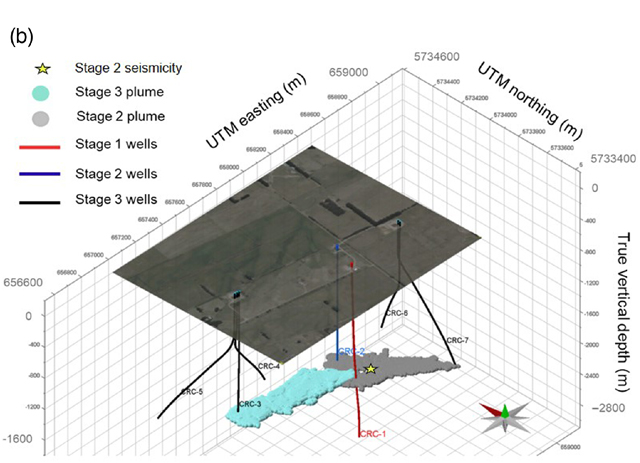21 July 2023–Researchers at a field site in Victoria, Australia are among the first to use fiber optic distributed acoustic sensing (DAS) for high-precision tracking of induced seismicity from a small carbon dioxide (CO2) injection, according to a new study published in Seismological Research Letters.
The CO2CRC Otway Project in Victoria is a research test site for the subsurface storage of carbon dioxide, as one possible way to reduce the impacts of climate-warming carbon emissions. However, there is a risk of induced earthquakes after gigatons of carbon dioxide are injected within the same geologic basin by multiple storage projects over decades of operations, and scientists would like to better understand how this seismicity is triggered and how it evolves over time.
Among the interesting details uncovered by the new DAS deployment at Otway: the tiny earthquakes that accompanied two injection phases at the site appear to follow the saturation front of the CO2 plume within the rock, rather than the pressure front from injection.
“As far as we know, the Otway Project remains the only CO2 storage project where induced seismicity was at the very least coincident with the saturation front movement, not the pressure front,” said study lead author Stanislav Glubokovskikh of Lawrence Berkeley National Laboratory.
“We relied on the frequent snapshots of the storage formation to relate the CO2 plume evolution to induced seismicity,” he added. “It is hard to think of another practical monitoring system apart from the multi-well DAS vertical seismic profiling which could provide such temporal and spatial resolution for a small CO2 plume.”

The seismic monitoring system was designed by a group of geophysicists at Curtin University in Perth, Australia, led by Roman Pevzner and Boris Gurevich, to rely on five deep boreholes outfitted with sensitive fiber optic cable to monitor a 15,000 metric ton CO2 injection, called Stage 3, at the Otway site over 610 days. They detected 17 tiny seismic events during that period, with a maximum magnitude of 0.1.
An earlier “Stage 2C” CO2 injection at the site, of the same size, was monitored at the time using geophones buried below the surface that detected several microseismic events.
Part of the focus of the Stage 3 injection was to look more closely at potential cost-effective, long-term monitoring of geological carbon storage, said Glubokovskikh. “To enable the long-term monitoring, we had to use a permanent downhole installation of the seismic sensors. Otherwise, deployment and demobilization of the array for each active seismic survey would be prohibitively costly and cause too much interruption to the land owners. DAS is the optimal technology for such conditions.”
The DAS observations also revealed the seismogenic fault below the surface, which was not captured in earlier seismic images.
Glubokovskikh said it’s still unclear exactly what mechanisms are triggering the small earthquakes at the site, although the interesting observation that the seismicity coincides with CO2 saturation may offer some clues.
“Geochemical weakening of the reservoir faults by CO2 seems like a plausible explanation, given that some of the core samples from the injection interval broke down during CO2 core-flooding experiments,” in the lab, Glubokovskikh explained.
But the mineralogical composition of the fault gauge and the flow and pore fluid composition at the site are still unknown, making it hard to confirm geochemical weakening, he noted.
Apart from the seismic events triggered within the Stage 2C CO2 plume, a second group of events occurred outside of any CO2 accumulation areas. “These [second group] events occurred only during the injection operations, but showed no clear relationship to either the injection pressure or saturation plume movement,” said Glubokovskikh.
The Otway project is moving toward a Stage 4 injection, which will occur close to the previous two CO2 plumes, he said. “Thus, we will likely get another set of induced seismic events that will provide more insights into the triggering mechanism. Even if the new injection will produce no detectable events, this fact may be perceived as another evidence of the flow-related nature of the Otway seismicity.”
